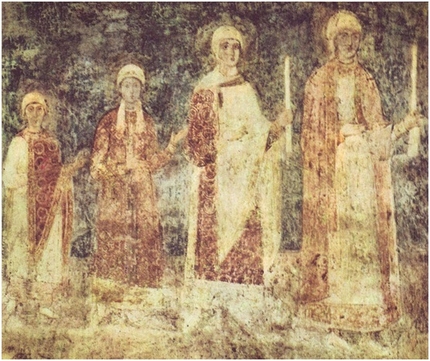
Anastasia of Kiev (born in Novgorod or Kiev around 1023, † after 1074 in Admont in Germany), Queen of Hungary (1046-1077)
Father
- Yaroslav Vladimirovich the Wise, Prince of Rostov (987-1010), Prince of Novgorod (1010-1034), Grand Prince of Kiev (1016-1018, 1019-1054)
Mother
- Ingegerd Olofsdotter of Sweden
Biography
Anastasia was one of the daughters of Yaroslav the Wise. She was born ca. 1023 in Novgorod. In the earliest sources do not provide the name of Yaroslav’s daughter. It is only Polish chronicler Jan Dlugosz who calls her Anastasia [III, p. 107, 256], while in Antonio Bonfino’s writing she appears under the name Agmunda [1, p. 25]. A. V. Nazarenko thinks that Anastasia is called Agmunda due to a misunderstanding or an error. The scholar thinks that the name Anastasia remains spurious [1, p. 25]
Anastasia became married to the future king of Hungary, Andrew I the White of Hungary. Ca. 1034 together with the brothers Bela and Levente Andrew was forced to leave Hungary and ended up at the court of Yaroslav the Wise, where he converted to Christianity [5, p. fifty]. Having been on Prince of Kiev’s service for a long time, Andrew did not abandon his attempts at regaining the Hungarian throne. One of the ways to ensure Yaroslav’s support of Yaroslav was to enter into a dynastic alliance with him by marrying one of his daughters.
The date of the wedding remains subject to historiographical controversy. A.V. Nazarenko suggests 1046 [I, p. 137. note 79] while A. Yu. Karpov argues for an earlier date: 1041/1042 [2].
With a military help of his father-in-law Andrew managed to return to Hungary and become king in 1046 [4, p. 170-174]. During his reign and probably under Anastasia’s influence Eastern Christianity spread in Hungary. Several monasteries were founded - in Visegrád and some other [1, p. 25; 2; 3, p. 211, etc.] Some scholars believe that due to Andrew’s illness it was Anastasia how had the real power [3, p. 211]. Anastasia and Andrew had two sons — Solomon and David. Sometimes the eldest daughter, Adelaide, is also considered as a child of this marriage [2], but she could also be Andrew’s daughter from the first marriage [6]. Andrew having been paralyzed, Solomon was proclaimed heir; probably, it was done under Anastasia’s influence, although this decision contradicted the previous agreement between Andrew and his brother Bela. For this reason, a war broke out between the two. After Andrew’s death in 1060, Anastasia became regent under Solomon, but he was soon forced to leave Hungary. Anastasia was received by the German emperor Henry III, whose daughter married Solomon [1, p. 25]. After a short reign of Bela I and his death three years after ascending to the throne, Solomon was over again proclaimed king of Hungary and returned to his country. However, a new war broke out, this time between him and the sons of Bela I. Once again Anastasia had to take refuge in the Styrian monastery of Admont, where she spent the rest of her life. According to another hypothesis, she remarried the German count Potto [2]. The exact date of her death and her burial place are unknown [4, p. 183].
Children
- Solomon (c. 1052 – March 1087), king of Hungary (1063–1074)
- David (1053 / 1055–1094)
- Adelaide (c. 1040-27 January 1062) (?), Duchess consort of Bohemia. There is no consensus about who was Adelaide’s mother. The princess could be Andrew’s child from his first marriage [2; 6]
Demesne
Information
The so-called Sword of Attila, a weapon which allegedly belonged to the king of the Huns, and subsequently presented by Anastasia to Duke of Bavaria Otto of Nordheim as a token of gratitude for helping her son Solomon in his fight against cousins.
Sources
I. Adam Bremenskii. Deianiia gamburgskikh arkhiepiskopov // Drevniaia Rus' v svete zarubezhnykh istochnikov: Khrestomatiia / Pod red. T.N. Dzhakson, I.G. Konovalovoi, A.V. Podosinova. T. 4. Zapadnoevropeiskie istochniki. Sost., per. i komment. A.V. Nazarenko. M., 2010. S. 122–152.
II. Shimon Kezai. Deianiia vengrov // Drevniaia Rus' v svete zarubezhnykh istochnikov: Khrestomatiia / Pod red. T. N. Dzhakson, I.G. Konovalovoi, A.V. Podosinova. T. 4. Zapadnoevropeiskie istochniki. Sost., per. i komment. A.V. Nazarenko. M., 2010. S. 348–353.
III. Shchaveleva N.I. Drevniaia Rus' v Pol'skoi istorii. Iana Dlugosha (Knigi I-VI). Tekst, perevod, kommentarii / Pod red. i s dopolneniiami A.V. Nazarenko M., 2004.
IV. Adam Bremensis. Gesta Hammaburgensis ecclesiae pontificum // Quellen des IX und XI Jahrhunderts zur Geschichte der Hamburgischen Kirche und des Reiches / Neu uertr. von W.Trillmich. Darmstadt, 1961.
Bibliography
1. Drevniaia Rus' v srednevekovom mire: entsiklopediia / Pod obshch. red. E.A. Mel'nikovoi, V.Ia. Petrukhina. M., 2014.
2. Karpov A. Iu. Anastasiia Iaroslavna // Obrazovatel'nyi portal "Slovo' https://www.portal-slovo.ru/history/35770.php
3. Morozova L.E. Velikie i neizvestnye zhenshchiny Drevnei Rusi. M., 2009.
4. Shternberg Ia.T. Anastasiia Iaroslavna, koroleva Vengrii // Voprosy istorii. 1984. № 10. S. 180–184.
5. Iurasov M.K. Russko-vengerskie otnosheniia vtoroi treti XI v. // Mir istorii. 2002. № 3. S. 4–44.
6. Osobnosti-Česko: Ottův slovník. Praha, 2008.
Links
Карпов А. Ю. Анастасия Ярославна // Образовательный портал «Слово»
